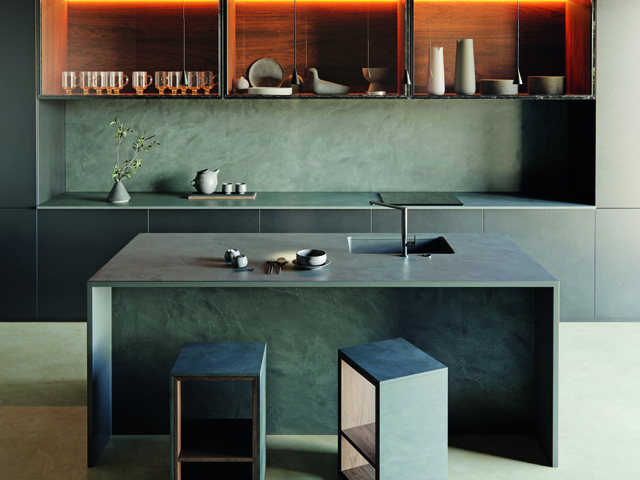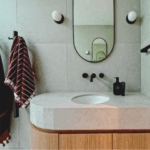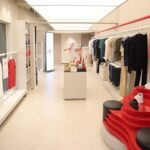Industry changes ahead for engineered stone
Concerns have recently been raised regarding engineered stone products and the hazards they present for those who work with these materials. The use of artificial stone for a variety of building applications has grown at a rapid rate since its introduction in the 1990s.
While many leading manufacturers have already taken steps to ensure the protection of their workforce, public awareness is key to understanding this engineered product as the government moves forward to help regulate this issue.

GALLERY
What is Silica?
Silica is a common mineral found in rocks, sand and soil. When these materials are cut, drilled or otherwise disturbed, fine particles of silica dust can be released into the air. When workers inhale these particles, they can become trapped in the lungs, causing damage and scarring that can lead to a diagnosis of silicosis.
What is Silicosis?
Silicosis is most commonly associated with long-term workers exposed to dust particles as a result of their occupation, such as those in the construction, mining and manufacturing industries. Preventing silicosis involves reducing exposure to silica dust in the workplace. This can be done by using engineering controls, such as ventilation systems and wet cutting methods, to minimise dust exposure. Personal protective equipment, such as respirators, can also be used to protect workers from inhaling silica dust.
From the shocking reports surfacing regarding silicosis and other dust related diseases, Australian health and safety ministers across the states and territories are stepping up to regulate silica exposure in the workplace.

Ceasarstone Clearskies Quartz
Latest findings
A recent report published by BMJ has found some startling results in regards to the effects of manufactured stone on workers. With statistics showing that one in four stone workers could have silicosis or other forms of dust diseases due to working with manufactured stone, calls to ban manufactured stone are rising.
According to the report, 541 workers aged between 34 to 50 years of age were screened with results showing 86.2 percent of workers have been exposed to dry processing of stone, with another 28.2 percent diagnosed with silicosis.
The report’s release coincided with the establishment of a new national disease registry, one of the key recommendations of the National Dust Diseases Taskforce.
In an industry struggling to attract workers and overcome lingering supply chain issues, the future of the manufactured product was far from set in stone.
Federal assistant minister for health and aged care Ged Kearney said silicosis had a devastating impact on workers and their loved ones. “This is an entirely preventable illness, and all too often leads to entirely preventable deaths,” Kearney said.
“The new national registry is an important step forward to support early detection of new cases and identify workplaces and industries that require greater scrutiny.”
Lung Foundation Australia senior manager Elizabeth Early said the BMJ report was a vital piece of work that highlighted how widespread, dangerous and under-diagnosed silicosis was in Australia.
“The focus must now be upon commencing an importation ban on the use of engineered stone products, and ensuring there is nationally consistent legislation for the monitoring and health surveillance of workers exposed to silica dust across all affected industries.
“Legislation introduced into Federal Parliament this week to establish a national registry for mandatory reporting of silicosis and all occupational respiratory diseases is an important first step.”

Cosentino Dekton Ambience
What Happens Next?
After bans and regulations are put in place, what will happen to the engineered stone market?
While alternatives such as stainless steel, timber, laminate, polished concrete and porcelain are an option, the beauty of engineered stone is not in question. Perhaps it is just a question of improving the product to mitigate risks.
A call to improve working conditions and educating workers has been building ground over the last decade in order to minimise risks to those that work with this material. One company committed to reducing the hazards of working with silica and helping to educate on this issue is Cosentino.
Cosentino manufactures solid surface brands Silestone® and Dekton. A world leader in the manufacture of luxury mineral surface products, Cosentino is ahead of the game when it comes to transforming the manufacturing of engineered surfaces.
Over the last 10 years, Cosentino has undertaken comprehensive research and development programs to substantially reduce the crystalline silica content of its Silestone® products to limit exposure to respirable crystalline silica.
Engineered stone products originally contained up to 95 percent silica, however Cosentino’s market-leading Silestone® Q10 and Q40 products contain less than 10 percent and 40 percent crystalline silica respectively.
Providing a low-silica product that can deliver high performance and durability has been at the core of Cosentino’s development work. Utilising a sustainable manufacturing process that uses 99 percent reused water, 100 percent renewable energy and zero waste water, Cosentino’s HybriQ Technology® is employed across its entire Silestone® range.
Empathetic to the health and safety concerns around engineered stone, Cosentino has also been working tirelessly to help educate the industry in best safety practices.
Cosentino’s Vice President Oceania, Itay Shimony, says, “We support the development of a nationally coordinated approach focused on the elimination (so far as is reasonably practicable) of health and safety risks associated with high-risk crystalline silica work. Providing a low-silica alternative that continues to deliver high performance and durability is at the heart of Cosentino’s entire range, providing Australian consumers with an ethically positive choice.”
Image Alireza Naseria via Unsplash
Building a new home presents a blank canvas, allowing you to create bespoke spaces for comfortable day-to-day living ...
This light-filled, custom-built Bayside residence by Dash Construct, is enhanced by light and architectural design that defines modern ...
Studio Tate has completed a lavish redesign of the 17th floor of a distinctive hexagonal building in Melbourne, ...
Red sculptural interventions define the interior of ARKS’ new flagship store in Bandra West, Mumbai, where Anagram Architects ...











